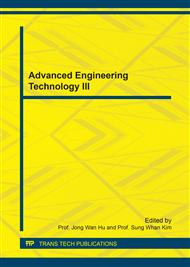[1]
G. Hu, J. Li, G. Zeng, Recent development in the treatment of oily sludge from petroleum industry: A review, J Hazard Mater. 261 (2013) 470-490.
DOI: 10.1016/j.jhazmat.2013.07.069
Google Scholar
[2]
A. Mohd Zain, M. G. Shaaban, H. Mahmud, Immobilization of Petroleum Sludge Incorporating Portland Cement and Rice Husk Ash, Int. J. Chem. Eng. Appl. 1(3) (2010) 234-239.
DOI: 10.7763/ijcea.2010.v1.40
Google Scholar
[3]
A. Mohd Zain, M. G. Shaaban, H. Mahmud, Leachability of Solidified Petroleum Sludge, Adv. Mater. Res. 917 (2014) 123-133.
DOI: 10.4028/www.scientific.net/amr.917.123
Google Scholar
[4]
B. D. Bone, L. H. Barnard, D. I. Boardman, P. J. Carey, H. M. Jones, C. L. Macleod, M. Tyrer, Review of scientific literature on the use of stabilisation/solidification for the treatment of contaminated soil, solid waste and sludges (CASSST, Trans. ), Environment Agency, West Almondsbury, Bristol, (2004).
Google Scholar
[5]
M. A. R. Silva, R. C. Testolin, A. P. Godinho-Castro, A. X. R. Correa, C. M. Radetski, Environmental impact of industrial sludge stabilisation/solidification products: Chemical or ecotoxicological hazard evaluation?, J. Hazar. Mater. 192(3) (2011).
DOI: 10.1016/j.jhazmat.2011.06.019
Google Scholar
[6]
J. R. Conner, S. L. Hoeffner, A Critical Review of Stabilisation/Solidification Technology, Crit. Rev. Envir. Sci. Tech. 28 (4) (1988) 397-462.
Google Scholar
[7]
M. W. Dean, Method for isolating, immobilizing and rendering waste non-leachable, US Patent 5643170 A (1997).
Google Scholar
[8]
ASTM, Standard Test Methods for Sampling and Testing Fly Ash or Natural Pozzolans for Use in Portland - Cement Concrete (2014).
DOI: 10.1520/c0311-02
Google Scholar
[9]
X. Y. Zhang, C. C. Wang, S. Q. Zhang, X. J. Sun, Z. S. Zhang, Zeolite cement mix to stabilize the mercury in waste surrogate, J. Hazar. Mater. 168(2-1) (2009) 1575-1580.
Google Scholar
[10]
J. Ivan, K. L'udovit, D. Martin, Properties and Utilization of Zeolite-Blended Portland Cements, Clay. Clay. Min. 51(6) (2003) 616-624.
DOI: 10.1346/ccmn.2003.0510606
Google Scholar
[11]
Y. S. Ok, J. E Yang, Y. S. Zhang, S. J. Kim, D. Y. Chung, Heavy metal adsorption by a formulated zeolite-Portland cement mixture, J. Hazar. Mater. 147(1-2) (2006) 91-96.
DOI: 10.1016/j.jhazmat.2006.12.046
Google Scholar
[12]
USEPA, Solidification/Stabilisation Resource Guide, U. S. EPA Washington, Office of Solid Waste and Emergency Response: 91 (1999).
Google Scholar
[13]
ASTM International, C109-91 Standard Test Method for Compressive Strength of Hydraulic Cement Mortars, Cement, Lime Gypsum, 04. 01 (2005), pp.76-81.
Google Scholar
[14]
V. A. Karamalidis, A. K. Voudrias, Cement-based stabilisation/solidification of oil refinery sludge: Leaching behaviour of alkanes and PAHs, J. Hazar. Mater. 148(1-2) (2006) 122-135.
DOI: 10.1016/j.jhazmat.2007.02.032
Google Scholar
[15]
S. Asavapisit, W. Nanthamontry, C. Polpraset, Influence of condensed silica fume on the properties of cement-based solidified wastes, Cem. Concr. Res. 31 (2001) 1147-1152.
DOI: 10.1016/s0008-8846(01)00541-5
Google Scholar
[16]
J. F. Lamond, J. H. Pielert, Significance of Tests and Properties of Concrete and Concrete-Making Materials (169 Ed. ), ASTM International (2006).
DOI: 10.1520/stp169d-eb
Google Scholar
[17]
S. Kon, N. H. Chen, New York Patent No. 4113504 (1977).
Google Scholar
[18]
S. T. Dealy, Zeolite-containing cement composition, Google Patents (2005).
Google Scholar


